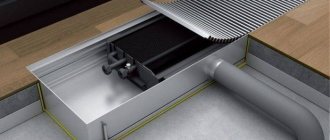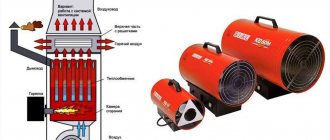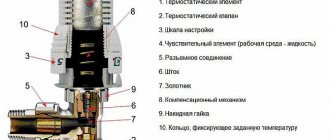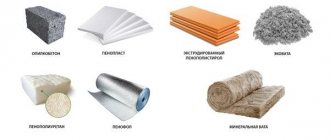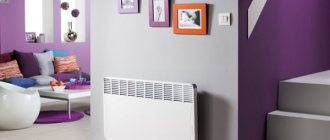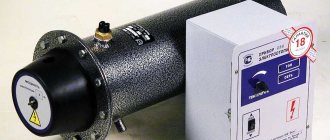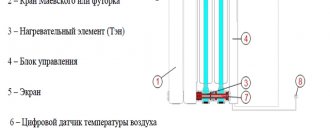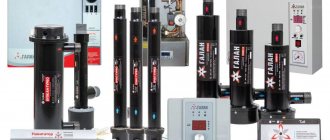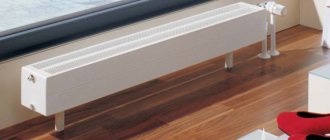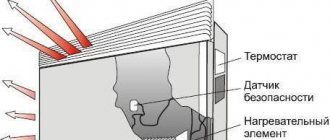Traditional water heating in our country is complex and expensive at the installation stage. Therefore, many are looking for other options for heating rooms, cottages, cottages and apartments. The first thing that comes to mind is electric heating convectors. Installation is super simple: set it up or hang it up, plug it into a power outlet. All. You can warm up. The only limitation is whether the wiring can withstand such a load. The second is decent electricity bills, but they can be reduced by installing a two-tariff meter.
Electric heating convectors can be the main or additional heat source
What is convection and convector
Convection is the process of heat transfer due to the movement of heated air. A convector is a device that heats air and promotes its movement. There are convectors in which heating occurs due to the circulation of coolant, then they are part of water heating. But we will talk about electric convectors, which convert electricity into heat, and air flows carry this heat throughout the room.
According to the installation method, convector electric heaters are wall-mounted, floor-mounted, in-floor (built in below floor level), baseboard and universal (installed on legs that come included or hung on the wall).
Convection heating principle
It is impossible to say which form of electric heating convectors is better. All forms are developed taking into account thermodynamics (at least, normal companies do this this way), so you base your choice only on your own preferences and on which design fits best into the design of the room. No one forbids installing electric convectors of different types in one apartment, house, or even in a room. The main thing is that the wiring can withstand.
Review of popular brands
Models of electric convectors are produced by manufacturers in different countries of Europe, Asia, and America.
Let's name just a few of them:
- Arbonia . A Swiss-German company producing steel pipes, heating radiators, heated towel rails and convectors. The company's product range is extremely extensive, and almost all products can be purchased in Russia. The offered models of convectors are very diverse: they have different shapes, colors and sizes. The company also accepts orders for non-standard products, such as corner units.
- Buderus . The German brand, now part of the Robert Bosch GmbH concern, originated in the first half of the 18th century. Initially, the company produced cast iron elements for making hearths, and from the beginning of the 20th century it began producing heating devices, including those powered by electric current. The company produces highly efficient, high-quality convectors that combine high technical characteristics and attractive appearance. In 2012, the company was awarded the Red Dot Award, awarded for achievements in the field of design.
- Kermi . The start of production of this German company dates back to 1960. The company produces various types of products, including shower cabins and heating equipment, but it is convectors, widely represented in Russian stores, that are the hallmark of the company.
- Purmo . The company, founded in the Finnish town of the same name, has been producing heating devices that can withstand the cold climate of the northern country since the late 1950s. In the early 1970s, after the company became part of the Rettig concern, production was significantly modernized and automated. Now the company's products are known all over the world: they are exported not only to European countries, but also to other continents.
- Zehnder . The Swiss company, created at the end of the 19th century, specializes in the production of luxury products. Its range includes heated towel rails, radiators and convectors of various types (ceiling, floor, wall), having a truly “cosmic” design. In addition to serial products, the company produces custom models, taking into account the individual requirements of clients.
In addition to the above companies, convectors from the French company Noirot, Norwegian Nobo, German Stiebel Eltron, Roda and other companies are popular.
Still can't decide on the choice of convector for your home? We recommend that you read the tips on choosing heating devices, which are given in our other article.
Installation of electric heating convectors
The design of the electric convector is simple:
- a housing in which there are openings for air intake and exhaust;
- a heating element;
- sensors and control and monitoring devices.
The case is heat-resistant plastic. The shape can be flat or convex, rectangular or square. The case has holes at the bottom - cold air is sucked into them. There are also holes in the top of the case. Heated air comes out of them. The air moves without stopping, and the room warms up.
Convector heater device
The heating element of an electric convector is what you need to pay attention to when choosing. The service life of the equipment and air conditioning depend on the type of heater.
Types of heating elements for electric convectors
There are three types of heating elements in electric heating convectors:
- Needle-shaped. This is a dielectric tape into which loops and needles made of an alloy of chromium and nickel are mounted. The surface of the heater is covered with a layer of protective varnish. The loops stick out on both sides, heat up very quickly, and cool down just as quickly, and this is a plus of such heaters - it’s easy to maintain the set temperature. The second positive point is low cost. Electric convectors with needle-type heaters cost a third less. Disadvantages - cannot be used in high humidity; the fragility of the needles leads to the fact that such a heating element quickly fails.
Needle heater for electric convector - heating element. Tubular electric heater. This is a hollow metal tube with a spiral sealed inside. The distance between the spiral and the body is filled with heat-conducting fill. Heating elements for convectors are additionally soldered with fin plates to increase heat transfer. The disadvantages of this heater are relatively low efficiency, high inertia - due to losses during heat transfer from the coil to the body - it takes time to reach operating mode. Another drawback: the heating element may crackle during operation. The reason is the different temperature expansion of the materials used. Advantages - the spiral is reliably protected, the convector heater can be used in damp rooms. Another positive point is the long service life.
Heating element with fins for fast heating of water - Monolithic heaters are the quietest, with minimal heat loss. The same nickel-chromium alloy thread is sealed in a cast housing with fins. Heat loss during transfer from the filament to the body is minimal, the thermal expansion of all parts is the same.
Monolithic heater
Electric heating convectors with monolithic heaters are considered the best, but they are also the most expensive. Using heating elements is a little cheaper.
Types of Thermostats and Controls
Electric heating convectors can be controlled using a mechanical thermostat or electronics. The cheapest convector electric heaters have a thermostat, which, when the set temperature is reached, breaks the power circuit of the heating element. When it cools down, the contact appears again and the heater starts working. Devices of this type cannot maintain a constant temperature in the room - the thermostat is activated by the heating of the contact plate, and not by the air temperature. But they are simple and quite reliable.
Mechanical thermostat on electric heating convectors Nobo
Electronic control uses several sensors that monitor the state of the air in the room and the degree of heating of the device itself. The data is processed by a microprocessor, which adjusts the operation of the heater. The desired mode is set from the control panel located on the case, and there are also models with a control panel. You can find programmable models that allow you to set the heating mode for a whole week - while no one is home, set it to maintain around +10°C or lower and save on bills; when people arrive, warm up the room to a comfortable temperature. There are generally “smart” models that can be integrated into the “smart home” system and controlled from a computer.
Principle of operation
How does a convection heater work? The body of the convector heater has holes: at the bottom and at the top. Cold air (without the help of a fan, of course) enters the heater through the bottom. The heating element heats the air, it becomes lighter, rises up and enters the room through the upper grille.
Operating principle of an electric convector
Modern models are equipped with thermostats that allow them to maintain the temperature that suits the user.
The most effective placement of the convector is under the windows. In this case, they create a thermal curtain against drafts. It is better to buy two low-power convectors for each window than one powerful one for only one window!
Choosing an installation location
Or rather, the question is not this: which convector is suitable for fulfilling your wishes. If you want to bring the appearance of the room closer to the standard one, you can hang rectangular wall convectors under the windows. Models that can be installed under the ceiling attract a little more attention, but they are inaccessible to children and pets - they will not be able to get burned or “adjust” in their own way. The installation method is the same here - on brackets fixed to the wall. Only the shape of the brackets differs.
You can choose any location for installing the electric convector. It is only advisable that it is not covered by furniture
If you want your heating appliances not to be visible, you will have to choose between baseboard and in-floor models. There is a big difference in installation: skirting boards are simply installed and connected to the network, but for in-floor ones you will have to make special recesses in the floor - their top panel should be on the same level as the finished floor. In general, you cannot install them without major repairs.
These are floor-mounted convectors. They are also electric
Positive traits
Among the key advantages of the technical characteristics of such a device is that oxygen is not burned, the air does not dry out, and the humidity of the room remains unchanged. No less important is the fact that the temperature of the outer casing does not exceed 65 degrees, making it completely safe for adults and children.
Owners leave only positive reviews for electric convectors, because these units can be used in rooms even with high humidity.
In addition, the convector is equipped with an autonomous power supply system, so even in the event of a power outage, the device will continue to function uninterruptedly. There are models equipped with a special thermostat - naturally, a convector with such a device costs a little more, but the importance of the thermostat is difficult to overestimate, and besides, you can install one thermostat for a whole group of convectors if they are all located in the same room. Therefore, taking into account the reviews of the owners, electric convectors with a special thermostat are a very profitable and convenient purchase for further use.
Power calculation
If a convector is needed only as an additional source of heat - for periods of extreme cold - it makes sense to take a couple of low-power devices - 1-1.5 kW each. They can be moved to those rooms where the temperature needs to be raised. If convector heating is the only source of heat, everything is much more serious.
This is approximately how you can calculate the power of convectors
If you do everything “wisely,” you need to calculate the heat loss of a house or apartment and select equipment based on the calculation results. In fact, this is very rarely done. Much more often they calculate the required heating power by area: 10 square meters for heating. m area requires 12 kW of heat. But these are the norms for average ceiling heights - 2.50-2.70 m and average insulation. If the ceilings are higher (the volume of air needs to be heated) or there is “no” insulation at all, the power is increased by 20-30%.
Ideal heater for a summer house
The operating features of convector heaters make them ideal for country houses. Depending on the size of the room, you can choose the most suitable device in terms of power and thus reduce energy consumption as much as possible, as well as achieve a comfortable temperature. Thanks to excellent safety, environmental friendliness, heating speed, uniform distribution of air masses, silent operation and other characteristics
A convection heater is a better purchase than most other types of heaters. It is easy to install, safe to use, operates silently and quickly heats the room to the desired temperature.
Manufacturers, characteristics and prices
Electric convector heaters are produced by several companies that produce other household appliances - Electrolux, AEG, Hyundai, Stiebel Eltron, Zanussi. In addition, there are many companies that specialize in this type of technology or produce two or three more groups of products. Among them there are Russian manufacturers - Ballu, Termica, Ural-Mikmah-Term, Alvin. There is also a whole group of European brands:
- Airele, Noirot and Atlantic (France),
- Extra, Royal Thermo, Scoole, Timberk, WWQ (PRC),
- Frico (Sweden),
- NeoClima (Greece),
- Nobo (Norway)
and many more. Electric heating is the norm in Europe; water heating is rare here. Hence the number of companies producing such household appliances. But, as is usual in recent years, most companies have moved production to China, so the assembly is mainly Chinese, although quality control should be at the level.
Electric heating convectors can have a power from 0.5 kW to 2.5-3 kW. They operate mainly from a 220 V network; if necessary, three-phase ones can be found - from 380 V. With increasing power, the dimensions (mainly depth) and price increase. If we talk about prices on average, then the price for imported electric convectors is about $80-250, for Russian ones - $30-85.
| Name | Power | Additional functions | Installation type | Control type | Heating element type | Dimensions (D*W*H) | Price |
| AEG WKL | 0.5/1/1.5/2/2.5/3 kW | overheat protection | Wall | Thermostat | heating element | 78*370*450 | 105 — 195 $ |
| Airelec Paris digital 05DG | 0.5 kW | overheat protection | Wall | Electronic | Monolithic | 80*440*400 | 60-95 $ |
| Termica CE 1000 MR | 1 kW | Overheat protection + ionizer | Floor | Thermostat (mechanical) | heating element | 78*400*460 | 50 $ |
| Nobo C4F 15 XSC | 1.5 kW | Overheat and tip-over shutdown | Wall/floor | Electronic | heating element | 55*400*975 | 170 $ |
| Stiebel Eltron CS 20 L | 2 kW | Overheat protection + fan | Floor | Thermostat (mechanical) | spiral heating element | 100*437*600 | 200-220 $ |
| Stiebel Eltron CON 20 S | 2 kW | overheat protection | Floor | Thermostat (mechanical) | Stainless steel heating element | 123*460*740 | 450 $ |
| Noirot Melodie Evolution1500 | 1.5 kW | Overheat and tip-over shutdown | Wall-mounted (small height) | Electronic | Monolithic | 80*220*1300 | 300-350 $ |
| Ballu BEC/EVE – 1500 | 1.5 kW | Overheat and tip-over shutdown | Wall/floor | Electronic | Heating element Double G Force | 111*640*413 | 70 $ |
| Timberk TEC.PF1 M 1000 IN | 1 kW | Overheat and tip-over shutdown + ionizer | Wall/floor | Thermostat (mechanical) | Needle + quiet + economical | 100*410*460 | 65 $ |
| Dantex SD4-10 | 1 kW | Overheat and tip-over shutdown | Wall/floor | Electronic | Needle + quiet + economical | 78*640*400 | 45 $ |
Minuses
An electric convector type heater also has negative aspects:
- Makes a little noise while warming up.
- If the heating element burns out, you cannot replace it at home: you need to connect a tungsten filament and insulate the inside of the tube.
- The fact that the device does not have a fan ensures quiet operation, but the rate of heating of the room is slower than with forced circulation.
In warm and dry air, which is constantly moving, asthmatics and allergy sufferers do not feel very comfortable. Solution - purchase a convection heater with a built-in humidifier.
Useful additional features
When choosing electric heating convectors, pay attention not only to technical parameters. There are also additional functions that increase comfort and safety:
- Overheat protection. An additional sensor is installed on the case, which turns off the power when a threshold value is reached. Usually it is +60°C.
- Drop shutdown. This function is relevant for models with floor-mounted installation. If the position changes (falls or bends too much), the power turns off. This function prevents possible fires.
- Restart. When turned on again, the electric convector automatically sets the settings that were when it was turned off.
Skirting-type convector - very low and long
Overheat protection and drop shutdown are very useful features that increase the safety of the equipment. Something else you can pay attention to is how quiet or loud the unit is. It's not just the heating element (it usually clicks). When activated, the mechanical thermostat also clicks. When choosing convection heaters for your bedroom, quiet operation is very important.
Safety rules when using EC
Any type of electrical appliance requires compliance with certain safety rules. There are some restrictions for the use of convectors.
If the electrical wiring is in good condition, heating convectors can be left unattended for some time, especially if the models are equipped with overheating sensors
Safety regulations:
- Under no circumstances should the appliance be covered or used as a clothes dryer.
- It is not recommended to place the convector near an electrical outlet: the minimum distance at which the device should be located is 0.8 m.
- For rooms with a high content of water vapor, device models marked IP 24, indicating a high degree of moisture protection, are suitable.
In general, modern devices have a high level of reliability and fire safety.
